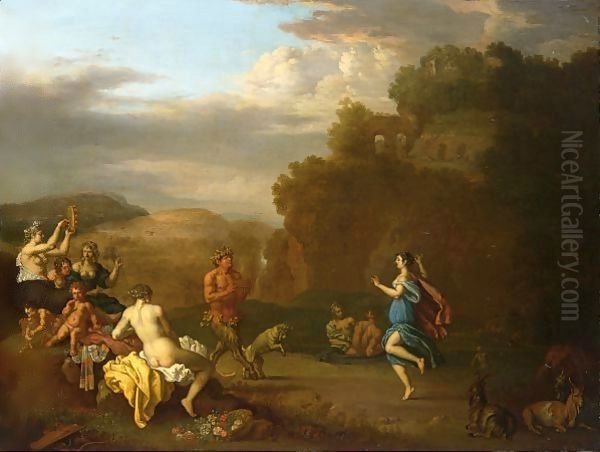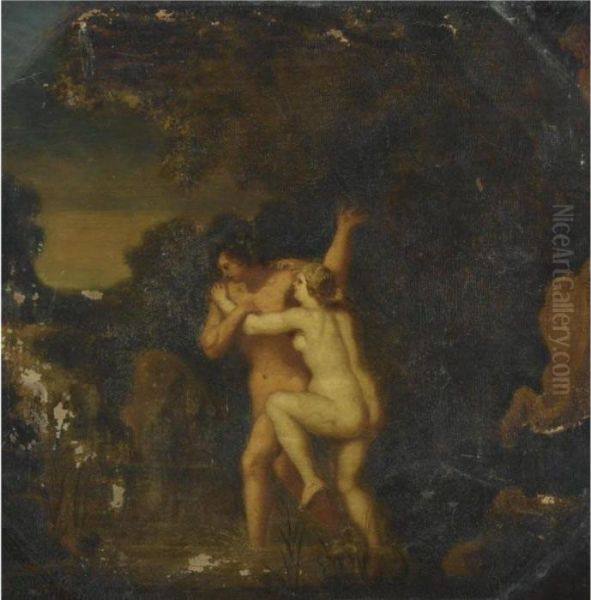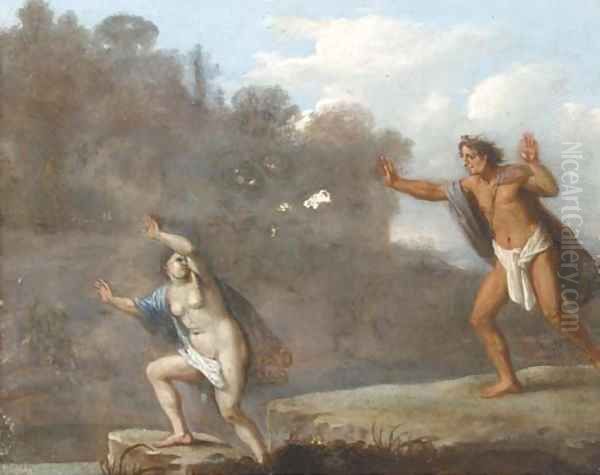Daniel Vertangen stands as an intriguing, if somewhat enigmatic, figure within the rich tapestry of Dutch Golden Age painting. Active during the 17th century, a period of unprecedented artistic flourishing in the Netherlands, Vertangen carved out a niche for himself primarily as a painter of landscapes, often imbued with mythological or biblical narratives. His artistic identity is inextricably linked to his tutelage under Cornelis van Poelenburch, one of the leading figures of the first generation of Dutch Italianate painters. While Vertangen may not have achieved the same level of widespread fame as his master or some of his more innovative contemporaries, his oeuvre offers valuable insights into the artistic currents of his time, particularly the enduring appeal of Arcadian landscapes and classical themes.
Early Life and Artistic Formation in the Dutch Golden Age
Born in Amsterdam, likely around 1598, Daniel Vertangen entered a world where art was becoming increasingly democratized and sought after by a burgeoning middle class. The Dutch Republic, having recently gained its independence, was experiencing a period of economic prosperity and cultural dynamism. This environment fostered a vibrant art market, with painters specializing in a diverse range of genres, from portraits and still lifes to genre scenes and landscapes. It was within this stimulating milieu that Vertangen would receive his artistic training.
The most significant formative influence on Vertangen was undoubtedly his apprenticeship with Cornelis van Poelenburch (c. 1594/95–1667). Poelenburch, a native of Utrecht, had spent a formative period in Italy, particularly Rome, where he absorbed the influences of artists like Adam Elsheimer and the burgeoning classical landscape tradition. Upon his return to Utrecht, Poelenburch became a highly successful and influential painter, renowned for his small-scale, meticulously rendered landscapes populated with graceful, often nude, figures drawn from mythology or scripture. His style was characterized by smooth brushwork, a luminous palette, and an idyllic, almost dreamlike atmosphere. Vertangen is consistently cited as one of Poelenburch's most dedicated pupils, alongside figures such as Dirck van der Lisse (1607–1669) and François Verwilt (c. 1620–1691).
The Enduring Influence of Cornelis van Poelenburch

The master-pupil relationship was a cornerstone of artistic training in the 17th century, and Vertangen's work bears the unmistakable imprint of Poelenburch's style and thematic preoccupations. So closely did Vertangen emulate his master that their works have, at times, been confused or misattributed. Vertangen adopted Poelenburch's preference for cabinet-sized paintings, ideal for intimate viewing in domestic settings. He, too, favored Arcadian landscapes, often featuring classical ruins, grottoes, and serene bodies of water, which served as settings for mythological episodes, such as nymphs bathing, bacchanals, or scenes from Ovid's Metamorphoses.
Vertangen's figures, like Poelenburch's, are typically elegant and delicately rendered, often with pale, smooth skin. His palette, while perhaps not always achieving the same subtle luminosity as his master's, often displays a similar sweetness and harmony. The compositions are generally balanced and carefully constructed, inviting the viewer into a tranquil, idealized world. This adherence to Poelenburch's model was both a strength and a limitation. It ensured a degree of commercial success by catering to an established taste, but it also meant that Vertangen's artistic voice, while competent and often charming, rarely strayed far from the path forged by his teacher. Other artists who followed in Poelenburch's Italianate landscape tradition, though perhaps with more individual variation, include Herman van Swanevelt and Bartholomeus Breenbergh, both of whom also spent significant time in Italy.
Artistic Style and Thematic Concerns
Daniel Vertangen's artistic output primarily consists of landscapes with staffage – small figures that animate the scene and often provide a narrative focus. His landscapes are not typically direct representations of Dutch scenery but rather idealized, Italianate vistas, reflecting the enduring influence of classical antiquity and the Italian Renaissance on Northern European art. These imagined landscapes provided suitable backdrops for his preferred subjects: mythological tales, biblical stories, and pastoral idylls.
Common themes in Vertangen's work include scenes of Diana and her nymphs, often surprised at their bath by Actaeon, a popular Ovidian subject. He also depicted bacchanalian revels, with satyrs and maenads frolicking in lush woodland settings. Biblical narratives, such as Lot and his Daughters, or Adam and Eve in the Garden of Eden, also feature in his oeuvre. These subjects allowed for the depiction of the nude or semi-nude figure, a hallmark of the classical tradition that Poelenburch and his followers embraced.

Vertangen's technique is characterized by a careful, detailed finish, often referred to as "fijnschilder" (fine painter) quality, though perhaps not as minutely detailed as Gerrit Dou or Frans van Mieris the Elder. His brushwork is generally smooth, aiming for an enamel-like surface. His use of color is often harmonious and pleasing, with a tendency towards soft blues, greens, and warm earth tones. While his compositions are well-ordered, some critics have noted that they can occasionally lack the dynamism or emotional depth found in the works of more innovative contemporaries like Rembrandt van Rijn or Jacob van Ruisdael. However, Vertangen's aim was different; he sought to create images of beauty, tranquility, and classical harmony, appealing to a taste for the refined and the idyllic.
Representative Works and Their Characteristics
Several paintings are consistently attributed to Daniel Vertangen and serve to illustrate his style and thematic preferences. "Nymphs Bathing in a Grotto" or similar titles appear frequently, showcasing his skill in rendering serene landscapes and graceful female nudes in the Poelenburch manner. These scenes often feature lush foliage, rocky outcrops, and tranquil pools of water, creating an atmosphere of secluded beauty. The figures are typically arranged in elegant poses, their pale skin contrasting with the verdant surroundings.
Another example might be a "Bacchanal," depicting a lively scene of mythological figures, satyrs, and nymphs celebrating with wine and dance. Such works allowed Vertangen to explore dynamic figure compositions and convey a sense of joyous abandon, albeit within the bounds of classical decorum. His biblical scenes, such as "Lot and his Daughters," would typically be set within a carefully rendered landscape, the figures conveying the narrative through gesture and expression, though often with a degree of restraint characteristic of his style.
The "Portrait of Dina Lems" is a notable work mentioned in some sources, suggesting that Vertangen also undertook portrait commissions. If this attribution is secure, it would indicate a broader range than his more typical mythological landscapes. Such a portrait would likely exhibit the same careful finish and attention to detail found in his other works, focusing on a faithful likeness while perhaps imbuing the sitter with a sense of quiet dignity.
A more unusual, and perhaps historically significant, attribution is a painting depicting the "Siege of Copenhagen" in 1659. If Vertangen indeed painted this, it would represent a departure into historical or topographical painting. Such a work would require a different set of skills, including the ability to manage complex compositions with numerous figures and architectural elements, and to convey the drama of a specific historical event. This contrasts with the timeless, Arcadian quality of his more typical output. The depiction of contemporary historical events was a genre practiced by artists like Pauwels van Hillegaert or Philips Wouwerman, though Wouwerman is more famous for his cavalry skirmishes and hunting scenes.
Vertangen and His Contemporaries

Daniel Vertangen operated within a vibrant and competitive artistic landscape. His primary connection was, of course, to the circle of Cornelis van Poelenburch. Besides Dirck van der Lisse and François Verwilt, other artists associated with or influenced by Poelenburch include Abraham van Cuylenborch and Gerrit van Bronckhorst. These artists collectively helped to popularize the Italianate landscape style in the Netherlands.
Beyond this immediate circle, Vertangen's work can be contextualized by comparing it to other trends in Dutch 17th-century art. While he focused on idealized landscapes, other painters like Jan van Goyen and Salomon van Ruysdael were developing a more distinctly Dutch, tonal approach to landscape painting, capturing the specific atmospheric qualities of their native land. Figure painters like Judith Leyster or Jan Steen focused on lively genre scenes, offering a different window into Dutch life.
The influence of earlier masters should also be considered. Adam Elsheimer (1578–1610), a German painter active in Rome, was a key figure for Poelenburch and, by extension, for Vertangen. Elsheimer's small-scale, meticulously detailed paintings on copper, often depicting biblical or mythological scenes in atmospheric landscapes, were highly influential. The broader tradition of Flemish landscape painting, exemplified by artists like Paul Bril, who also worked in Italy, provided a foundation for the development of Italianate landscapes.
While Vertangen's style remained relatively consistent, the art world around him was constantly evolving. The dramatic chiaroscuro of Caravaggio and his followers (the Utrecht Caravaggisti, such as Hendrick ter Brugghen and Gerard van Honthorst) had a profound impact in Utrecht, Poelenburch's home base, though Poelenburch himself and Vertangen leaned more towards a brighter, more classical aesthetic. Later in the century, artists like Nicolaes Berchem and Jan Both would further develop the Italianate landscape style, often on a larger scale and with a more heroic or pastoral grandeur.
Later Career and Legacy
Information regarding Daniel Vertangen's later career and the precise date of his death is somewhat debated in art historical literature, with some older sources suggesting a death date as early as 1657, while others propose he lived much longer, possibly until around 1681-1684, and may have died in Amsterdam. If the earlier date is correct, his active period would have been concentrated in the first half to mid-17th century. If he lived longer, he would have witnessed significant shifts in artistic taste.
Regardless of the exact chronology, Vertangen's legacy is primarily that of a skilled and faithful follower of Cornelis van Poelenburch. He did not forge a new artistic path or dramatically innovate within his chosen genre. Instead, he consistently produced works that catered to a prevailing taste for refined, idealized landscapes with classical or biblical themes. His paintings are characterized by their careful execution, pleasing compositions, and harmonious, if sometimes sweet, coloring.
In the grand narrative of art history, Vertangen is often overshadowed by his more famous master and by more groundbreaking contemporaries. However, his work contributes to our understanding of the breadth and depth of Dutch Golden Age painting. He represents a significant group of artists who, while not necessarily innovators, were highly competent craftsmen who met the demands of the art market and helped to disseminate popular styles and themes. His paintings, found in various museum collections and private hands, continue to offer a glimpse into an idealized, Arcadian world that held great appeal for 17th-century Dutch patrons. The study of artists like Vertangen provides a more nuanced picture of the art world of the time, highlighting the importance of workshops, the transmission of styles from master to pupil, and the varied tastes of contemporary collectors. His art, with its gentle charm and technical proficiency, remains a testament to a particular facet of the Dutch Golden Age's rich artistic production.
Conclusion
Daniel Vertangen was a Dutch painter of the 17th century who, under the tutelage of Cornelis van Poelenburch, became a proficient exponent of the Italianate landscape tradition. His works, typically small-scale and meticulously finished, depict idyllic scenes populated with mythological or biblical figures. While he closely followed the style of his master, sometimes to the point of their works being confused, Vertangen produced a body of work that is consistently charming, well-executed, and reflective of a significant taste in Dutch Golden Age art.
His paintings of bathing nymphs, bacchanalian scenes, and pastoral landscapes transport the viewer to an Arcadian realm, far removed from the everyday realities of 17th-century life. He shared this artistic space with fellow Poelenburch students like Dirck van der Lisse and François Verwilt, and his work can be seen in the context of other Italianate painters such as Bartholomeus Breenbergh and later figures like Jan Both and Nicolaes Berchem. Though perhaps not an innovator on the scale of Rembrandt or Vermeer, Vertangen's contribution lies in his skillful adherence to a popular and aesthetically pleasing genre. His paintings offer a window into the classical aspirations and refined tastes of Dutch art patrons, and they remain a delightful, if modest, part of the vast artistic heritage of the Dutch Golden Age. His dedication to the detailed and harmonious rendering of idealized worlds ensures his place as a noteworthy, if secondary, master of his time.